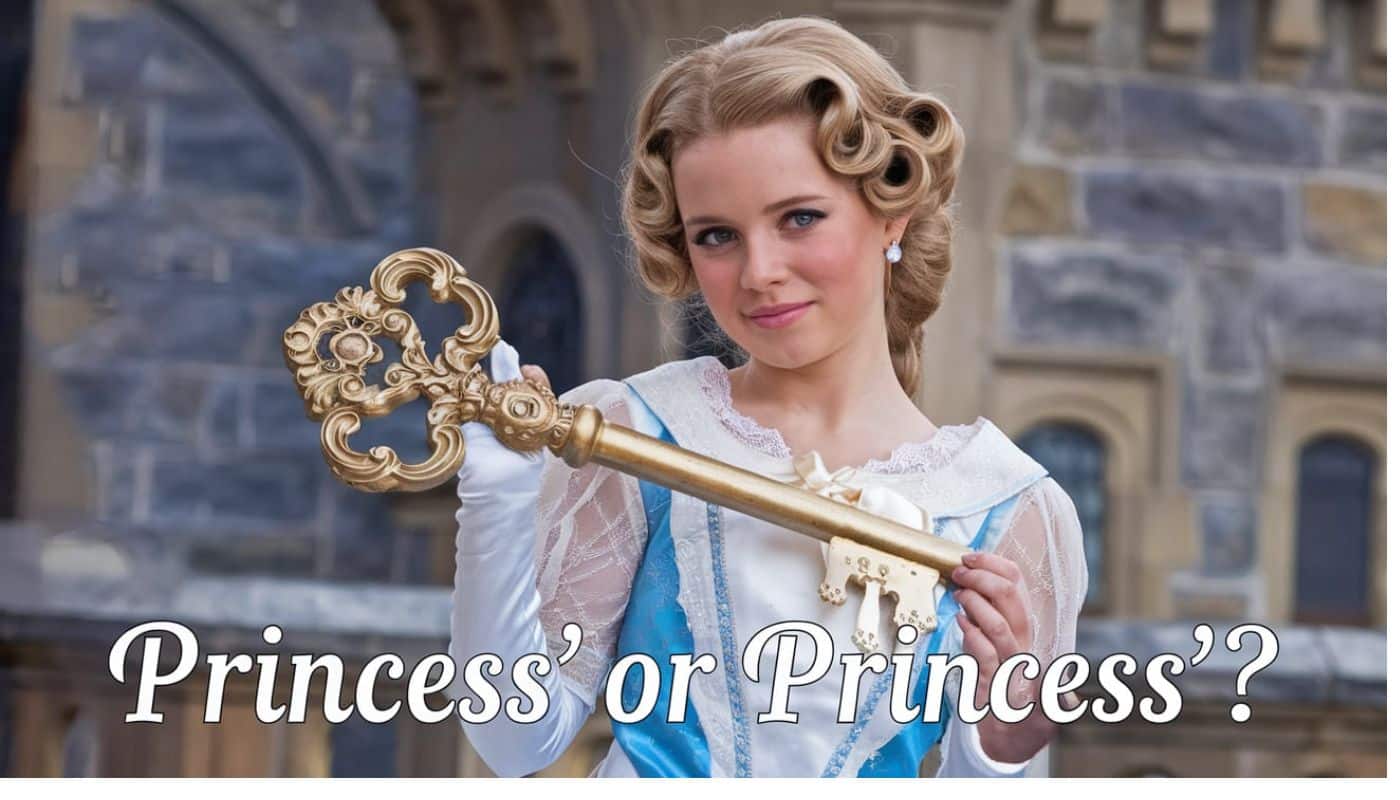Few topics in English grammar spark as much debate as the proper use of possessive forms. One common question that often leaves writers scratching their heads is whether to use “Princess’” or “Princess’s.” While it might seem like a minor detail, getting it right can make a world of difference in how polished and professional your writing appears.
Whether you’re drafting an email, writing a story, or preparing a report, understanding the nuances of possessive forms is essential for clear and effective communication. In this guide, we’ll dive deep into the rules, exceptions, and practical applications of “Princess’ vs. Princess’s,” so you can confidently navigate this grammatical challenge.
Quick Summary: What’s the Correct Form?
Before we dive into the details, here’s a quick answer to the burning question:
- Correct Singular Possessive Form: Princess’s (e.g., “The princess’s crown”)
- Correct Plural Possessive Form: Princesses’ (e.g., “The princesses’ gowns”)
Key Takeaways:
- In modern English, Princess’s is the preferred singular possessive form.
- For plural possessives, add an apostrophe after the “s” (princesses’).
- Regional variations (e.g., British vs. American English) can influence usage, but Princess’s is widely accepted.
Why the Confusion?
The confusion between “Princess’” and “Princess’s” stems from a few key factors:
- Historical vs. Modern Usage: Older style guides often allowed for the omission of the final “s” in singular possessives (e.g., “Princess’”), but modern usage favors adding the “s” for clarity.
- Pronunciation: Some argue that “Princess’” sounds more natural in speech, but written English prioritizes consistency and clarity.
- Regional Differences: British English sometimes omits the final “s” in singular possessives, while American English consistently includes it.
For example, you might encounter:
- British English: “The princess’ crown”
- American English: “The princess’s crown”
While both are technically correct, Princess’s is increasingly becoming the global standard.
Detailed Explanation & Correct Usage

Singular Possessive: Princess’s
The singular possessive form is used to show that something belongs to one princess. To form it, simply add an apostrophe followed by an “s” to the singular noun.
Examples:
- “The princess’s tiara was encrusted with diamonds.”
- “Everyone admired the princess’s grace and poise.”
Plural Possessive: Princesses’
When referring to something that belongs to multiple princesses, the plural possessive form is used. If the plural noun already ends in “s,” you only need to add an apostrophe.
Examples:
- “The princesses’ ballroom was decorated in gold and silver.”
- “The princesses’ shared love for music brought them together.”
Regional Variations
While Princess’s is the standard in American English, British English sometimes allows for Princess’ in singular possessives. However, this is becoming less common, and many British style guides now recommend Princess’s for consistency.
Common Mistakes & How to Avoid Them
Here are some frequent errors writers make when using possessive forms, along with tips to avoid them:
- Omitting the Apostrophe Altogether:
- Incorrect: “The princesss crown was stunning.”
- Correct: “The princess’s crown was stunning.”
- Using the Plural Form for Singular Possessives:
- Incorrect: “The princesses crown was lost.”
- Correct: “The princess’s crown was lost.”
- Adding an Extra “s” in Plural Possessives:
- Incorrect: “The princesses’s gowns were elegant.”
- Correct: “The princesses’ gowns were elegant.”
Pro Tip: If you’re unsure, try reversing the sentence to check for clarity. For example, “The crown of the princess” becomes “The princess’s crown.”
Synonyms or Alternatives

While “princess” is a specific term, there are times when you might want to use alternative words or phrases to avoid repetition or add variety. Here are some options:
- Royal lady: “The royal lady’s tiara sparkled.”
- Monarch’s daughter: “The monarch’s daughter’s speech was inspiring.”
- Regal figure: “The regal figure’s presence commanded attention.”
These alternatives can be useful in creative writing or when you want to emphasize different aspects of the princess’s role.
Examples in Sentences
To help you see these rules in action, here are some diverse examples of Princess’s and Princesses’ in use:
Singular Possessive:
- Formal: “The princess’s diplomatic skills were unmatched.”
- Informal: “Did you see the princess’s new puppy? It’s adorable!”
Plural Possessive:
- Formal: “The princesses’ charitable efforts have made a global impact.”
- Informal: “The princesses’ selfie went viral on social media.”
Origins & History
The word “princess” comes from the Old French princesse, which itself derives from the Latin princeps, meaning “first citizen” or “leader.” The possessive form has evolved over time, influenced by changes in pronunciation and writing conventions.
In earlier forms of English, possessive nouns were often indicated by adding an “-es” suffix (e.g., “princesses crown”). Over time, this evolved into the modern apostrophe + “s” construction. Interestingly, the debate over Princess’ vs. Princess’s reflects broader shifts in linguistic preferences and style guide recommendations.
Conclusion & Final Thoughts
Mastering the use of Princess’s and Princesses’ might seem like a small detail, but it’s these nuances that elevate your writing and ensure clear communication. Whether you’re writing an email, crafting a story, or preparing a report, understanding possessive forms is a valuable skill.
To recap:
- Use Princess’s for singular possessives.
- Use Princesses’ for plural possessives.
- Be mindful of regional variations, but lean toward modern standards for clarity.
By applying these rules, you’ll not only avoid common mistakes but also demonstrate a strong command of English grammar. So the next time you’re tempted to write “Princess’,” remember: a little extra “s” can go a long way in making your writing shine.

Emily Hudson, the creative mind behind “English Summa,” is a passionate English language educator with a Bachelor’s Degree in English and a Teaching Certification. Dedicated to making the intricacies of English accessible to learners, Emily brings a blend of expertise and enthusiasm to her readers. Follow English Summa for insightful language tips, literary explorations, and a shared love for the beauty of English.














